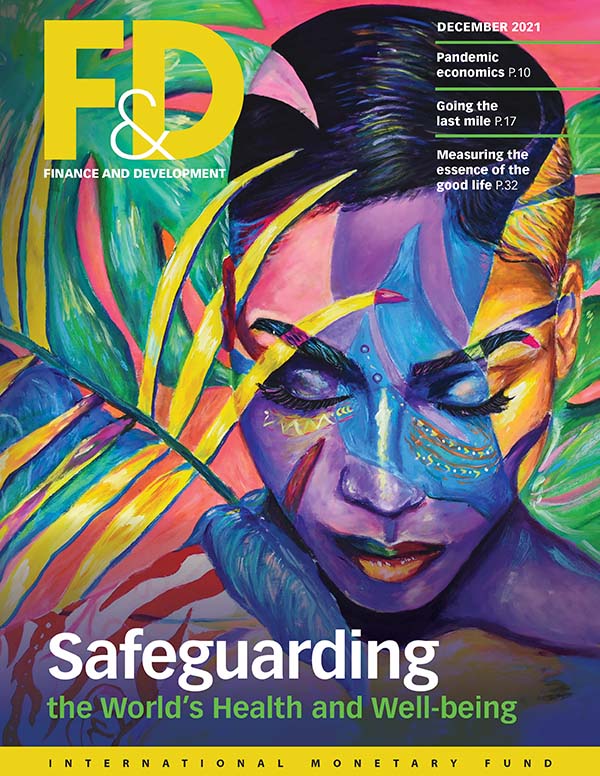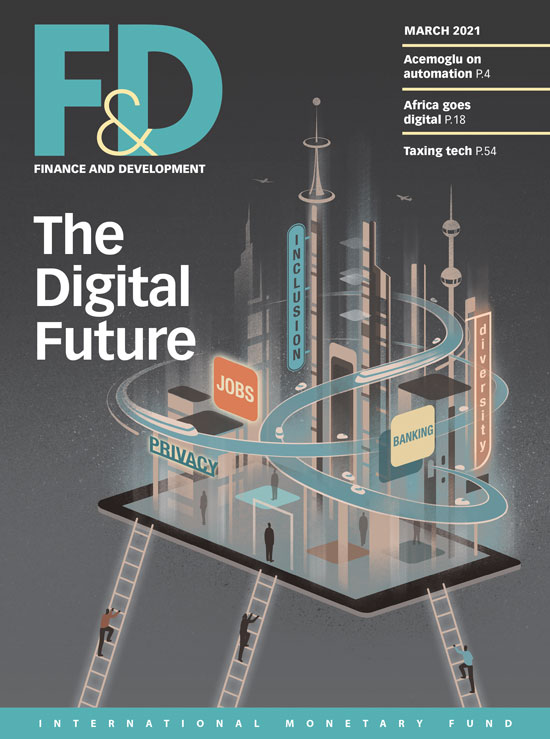Digital forms of money could be a boon for emerging market and lower-income economies if the transition is well managed and regulated
Digital money has the potential to transform the financial sector. Emerging markets and lower-income countries stand to gain the most from this dramatic shift. Broad and inexpensive access to digital money and phone-based transactions could open the door to financial services for 1.7 billion people without traditional bank accounts. And countries may grow increasingly connected, facilitating trade and market integration. The real-world impact is significant.
But with any opportunity comes risk. The passage to this new world could exclude those on the other side of the digital divide. It also opens the door to fragmentation, currency substitution, and loss of policy effectiveness. The transition must be well managed, coordinated, and soundly regulated.
What is digital money?
Digital money is the digital representation of value. The public sector can issue digital money called central bank digital currency—essentially a digital version of cash that can be stored and transferred using an internet or mobile application. The private sector can also issue digital money. Some forms can be redeemed for cash at a fixed face value. These are fully backed with very safe and liquid assets and are usually referred to as e-money. Stablecoins can be a form of e-money, but also come in other designs whose value is more volatile. Crypto assets, such as Bitcoin, are issued in their own denominations and are especially volatile—too much to be considered a form of digital money (they are usually considered an investment asset). Click here for a detailed discussion of different forms of digital money.
Emerging markets lead the way
Consider a worker in the United States. In the near future, an employer could deposit her paycheck in a digital wallet, allowing her to send money to relatives in Guatemala, the Philippines, or any other country more cheaply and efficiently. Fees for wiring money often take up to 7 percent of the value of a transaction, and the World Bank estimates that cutting fees to 2 percent could give a $16 billion a year boost to remittances to low-income countries.
This future is not distant. Private sector innovation in emerging markets has already made a mark in the area of mobile money. The M-pesa mobile money transfer service, which started in Kenya, is being replicated in dozens of countries in Africa and Asia. It has brought payments to many without bank accounts—but with a flip phone in their pocket—and has opened the door to other financial services, like savings and credit products.
Today, there are a billion registered mobile money accounts across 95 countries, with close to $2 billion transacted through these accounts every day. Sub-Saharan Africa is a leader in mobile money, accounting for almost half of mobile money accounts worldwide. The widespread use of mobile phones has made this possible. Digital identities, which many countries have rolled out, are another important innovation. These digital versions of passports allow mobile money providers to onboard customers at low cost while complying with local regulations.
The public sector too is taking steps to provide a digital payment infrastructure in emerging markets. The Bahamas is the first country in the world with a central bank digital currency (a digital form of a country’s currency). Called the “sand dollar,” it will increase financial inclusion for inhabitants spread out across the country’s 700 islands, where banking services such as cash machines are not always available.
Other countries are not far behind. The most ambitious project is being piloted by China’s central bank. If the e-Renminbi experiment is successful, it could boost digitalization, innovation, and financial inclusion in one of the world’s largest and most vibrant economies, possibly encouraging other countries to follow suit.
Maintaining a balance
But many of these potential benefits require careful and farsighted policy support. To start, new infrastructure is essential to allow poorer households in isolated areas to connect to new digital payment services. Global satellite networks (Starlink, OneWeb, and others) are expected to provide widely accessible broadband services, including to lower-income countries, as soon as 2022. But a financial inclusion strategy cannot rely on a signal simply falling from the sky.
A synchronized infrastructure investment push is needed including to broaden internet access to poorer and remote areas. In fact, when many countries act at the same time, public infrastructure investment can help lift growth domestically and abroad through trade linkages. These investments are necessary to support a viable digital payment strategy.
In many countries, financial inclusion may mean trade-offs when it comes to privacy and competition policy. Digital payment companies are increasingly capturing and monetizing consumer data. Without collateral to offer, poorer households and microenterprises can offer their data, but at the cost of their privacy. Regulation will have to strike just the right balance, including to incentivize market entry of new payment companies while limiting their dominance.
In fact, countries will need to ramp up regulatory and supervisory capacity more generally before payment innovations hit the market. Regulation and careful supervision are key to anchoring trust in new digital forms of money. However, questions still abound. Payment providers may well be required to fully back coin issuance with safe and liquid assets, but which assets? Should these be kept in commercial banks or perhaps even in central banks? What backstops might the state be prepared to offer? And what if the digital money is being offered by a foreign firm—how should regulators cooperate across borders? These questions are new and need to be pondered carefully.
Clear legal frameworks are also essential. Central bank–issued digital currencies will likely require adaptation to central bank law and monetary law. And public law must clarify the legal status of privately issued money. Should new arrangements be treated as electronic money, bank deposits, securities, commodities, or something else? Answers to these questions will have enormous bearing on the development of digital money. For instance, classifying a form of digital money as a security will significantly complicate its exchange, given the complexity of securities regulation.
Other risks must also be contained. New digital forms of money must stand up to cyberattacks, outages, technical glitches, fraud risks, and faulty algorithms. And without proper regulation, digital money could be a virtual safe haven for criminals’ illicit financial transactions. Effective implementation of a robust framework to combat money laundering and the financing of terrorism is needed. However, digital money also brings regulatory opportunities, such as more effective real-time data analytics and monitoring.
Current regulatory approaches and legal frameworks are fragmented. There is little guidance, and country circumstances differ significantly. The IMF has a role to play in providing policy advice to countries and helping institutions develop sound regulatory approaches and share best practices.
In their effort to join, benefit from, and regulate the digital money revolution, countries must not lose sight of the bigger picture. Regulatory and legal frameworks, as well as central banks’ decision to offer their own digital currencies, will affect private sector participation and innovation. The role of banks may change if they face more intense competition for funding as clients debate whether to exchange their deposits for the potentially safer currency of central banks. Careful decisions must also ensure that new forms of digital money are environmentally sustainable—that the energy they require is kept in check. The path to digital money adoption must be guided by a clear and responsible vision of tomorrow’s broader payment, financial, economic, and environmental landscape.
A global approach
The bigger picture actually extends far beyond each country’s borders. The digital money revolution will happen on a global scale. Emerging markets and lower-income countries will be affected by the introduction of digital forms of money in larger, more advanced economies. They must be aware of these changes, and the IMF will stand beside them to ensure that the international monetary system continues to work for all countries.
The lower costs of obtaining, storing, and spending digital money could make it easier for people and companies to substitute their domestic currency with a more stable currency, especially in countries with high inflation and volatile exchange rates. This practice is already widespread—foreign currency deposits exceed 50 percent in more than 18 percent of countries worldwide. As this level rises, the home country loses control over monetary policy. This has a disproportionate impact on poorer and more vulnerable households, which typically find it harder to diversify their savings to protect against volatile inflation.
Policies are currently being explored. In countries where there is risk of capital outflows, questions arise about the technical feasibility—and policy desirability—of limiting foreign digital currency transactions and holdings. It may be possible to agree on design principles that allow country authorities to set basic parameters for wallets and networks to limit currency substitution. However, these design principles must be coordinated at the global level to ensure that they meet the needs of all countries and that they are widely adopted to limit regulatory arbitrage. This is another area where the IMF can help through its analysis and convening power.
The question also arises of whether existing capital flow management measures—such as taxes on purchasing foreign currency—may be circumvented by digital forms of money. Most IMF member countries, particularly emerging markets and lower-income countries, use some form of capital flow management. Existing regulations and implementation practices must evolve so that capital flow management measures remain strong following the introduction of digital money.
Digital money would also likely increase gross capital flows as transaction costs diminish and financial products become more widely available. This comes with both pros and cons. Markets should become more integrated, offering risk-sharing and hedging opportunities for local households and firms. Yet the risk of financial contagion would also increase, as would the danger of balance of payments problems, since swings in asset valuations are amplified as the stock of foreign assets increases.
Finally, the risk of fragmentation and of a global digital divide is stark. Regional arrangements to settle digital money could proliferate, driven by countries’ desire for autonomy. Such arrangements could become instruments of geopolitical interests and forces—to avoid or impose bilateral sanctions—and could limit currency convertibility.
Yet there are also opportunities. Digital money could be leveraged to foster integration and interoperability of payment systems. New solutions must be explored, such as multilateral settlement and exchange platforms, as well as common norms or principles for the design of digital money to facilitate cross-border payments, such as remittance flows, which are essential for many lower-income countries. The IMF is actively working with the international community—member countries and other international organizations—to defend the integration of payment systems and oppose their fragmentation.
The IMF will play a key role in the new era of digital money. The organization was created to promote international monetary cooperation and oversee the stability of the international monetary system, as well as contribute to countries’ economic and financial stability. Digital money must be regulated, designed, and provided in a way that allows countries to maintain control over monetary policy, financial conditions, capital account openness, and foreign exchange regimes. Payment systems must grow increasingly integrated, not fragmented, and must work to help all countries guard against a digital divide.
Much remains to be done, but the opportunities are immense, to the extent the risks are carefully managed. The key to building a brighter future is cooperation—between the private and public sectors domestically and national authorities and organizations internationally. The IMF, with its near universal membership, stands ready to play its part in this momentous endeavor.
Opinions expressed in articles and other materials are those of the authors; they do not necessarily represent the views of the IMF and its Executive Board, or IMF policy.










